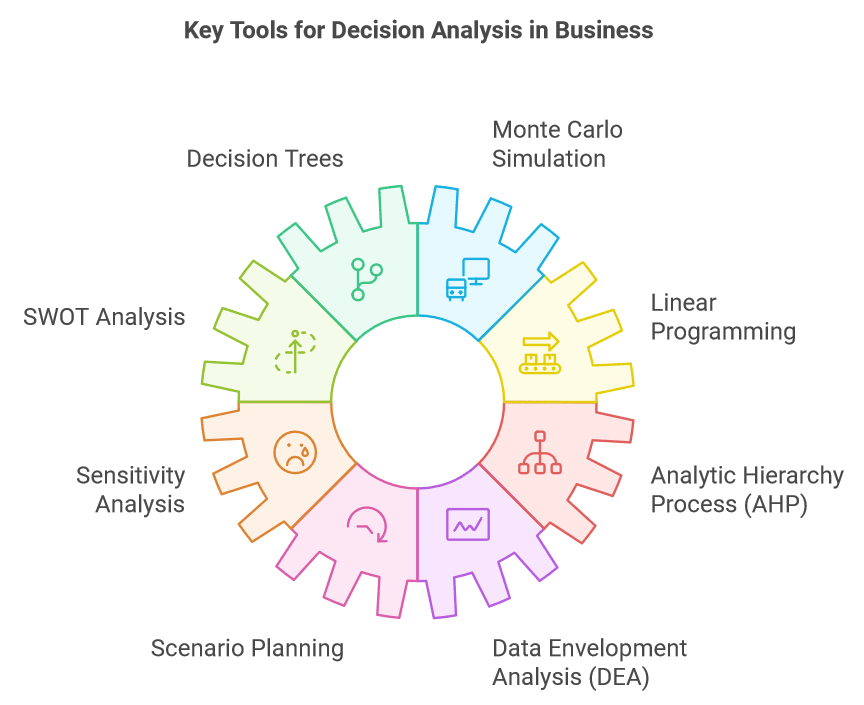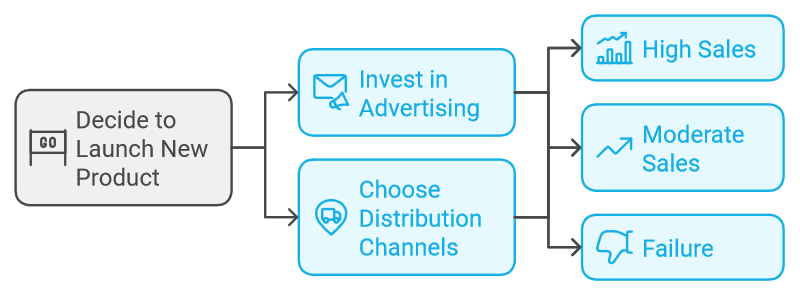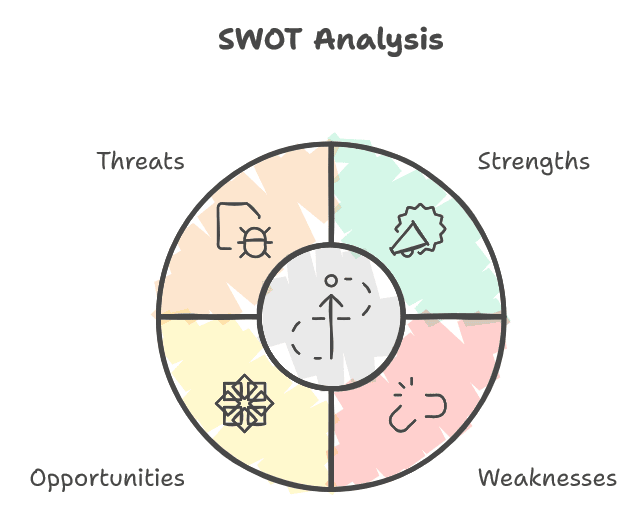Decision analysis is the systematic, mathematical and visual method used to solve and appraise various choices faced by organizations. It is a set of tools and methods used to anticipate outcomes, assess risks associated with an action and make the right decision under uncertain conditions. From deciding on the appropriate multichannel marketing campaign type to deciding on strategic investments or analyzing which operational procedures can be improved to optimize efficiency, decision analysis aids businesses in managing the complex issues with data driven insights. Decision analysis is important for business analytics students because it encapsulates the process through which raw data is analyzed and converted into useful information for decision-making.

In this information age, decision analysis has even greater significance than it used to have. A report by McKinsey Global Institute, it showed that businesses that have incorporated the use of analytical data are 19 times more likely to be profitable than those that have not. At the same time, due to the increased use of Big Data, many companies need specialists who can delve into the specifics of complex data, use tools for decision-making, and provide strategic recommendations for effective business outcomes.
For students studying this topic, performing decision analysis in business analytics assignments provides students with a significant competitive edge of attaining a blend of statistical knowledge, predictive modeling ability, and strategic thinking acumen. Students who are in need of business analytics assignment help can find new and better ways of looking at things and addressing the problems they encounter in their coursework assignments. Let’s explore eight crucial tools that are used in decision analysis.

A decision tree is defined as the visual presentation of decision paths and potential results. It is an analytical tool that reduces decision-making complexities by presenting decisions as a set of options each with its risk, costs, and benefits. Decision trees break down complex decisions into manageable parts and examine the probability of outcomes by structuring choices in a systematic, visual manner.
Example: Let’s take an example of decision tree being used to determine whether a retail company should introduce a new product. The tree would show the probable decisions (such as advertising spends, changing distribution channels) and their outcomes (Such as increase in revenue, profitability or failure).

Microsoft Excel or R are the most suitable tools that the students can use to design the decision tree for their business analytics tasks.
Case Study: Decision trees were used in 2018 by Netflix to better its recommendation systems. The utilization of decision trees in analyzing user behavior and choice patterns presented Netflix with the opportunity to enhance its user engagement and retention hence improving business success.
Monte Carlo simulation helps analysts to weigh the influence of risk and uncertainty factors in decision-making. As it produces results from multiple simulations that incorporate various parameters, this tool gives a probability-based picture of viable scenarios. It can be most helpful when decisions are contingent upon elements that are potentially volatile such as stock prices, consumer demand, or interest rates.
For students, Monte Carlo simulations can be really useful in case of business situations with uncertainty. Software packages such as MATLAB, Crystal Ball, or Risk Solver can perform simulations and give multiple potential outcomes.
Example: Logistics is a strong field for the application of Monte Carlo simulations; this might be applied in risk assessment for delivery delays due to factors such as harsh weather conditions, political instabilities, and industrial actions.
A management tool known as the SWOT (Strengths-Weaknesses-Opportunities-Threats) is a tool used to evaluate the external as well as organizational internal factors influencing the objectives of an organization. It is mostly used in the marketing field but it can be applied in other business areas.

A clear benefit of using the SWOT analysis tool is that, students can assess a company and its market position, as well as strengths and weaknesses, and threats and opportunities that are present in the current business environment and directly contribute to business strategy formulation. It is very useful when making qualitative evaluations apart from quantitative data analysis.
Example: If a student is required to submit an assignment on the business level strategy, let’s presume, Apple Inc. SWOT analysis may reveal strengths as a brand and innovation while weaknesses be the overreliance on hardware, opportunities in expanding in emerging markets, and threats from new rivals such as Google Android phones.
Case Study: SWOT analysis has helped Coca-Cola Company to relevantly contest the beverage market since it always evaluates its strengths and weaknesses consistently alongside identifying potential threats.
Linear programming is an optimization tool that gives the optimal solution to a problem from a set of constraints. This is mostly used in operations research to find the maximum profit or the minimum cost. As for applications, linear programming is useful to work with problems that involve decisions about resource allocation, timetable planning, or production planning or budgeting for marketing campaigns that business analytics learners may encounter in their assignments.
Software like LINDO, Gurobi, or even Excel Solver can help students build models to solve linear programming problems.
Example: An actual situation where an organization can apply the concept of linear programming is a manufacturing unit that wants to manufacture products to meet customer’s demand while incurring the least cost possible. Optimization of variables such as labor hours and material cost are possible thereby making business decisions cost efficient and effective.
Case Study: Linear programming has been employed at Dell to improve its supply chain and production schedules so that products are delivered on time and at minimal cost.
Sensitivity analysis can be defined as the degree of change in the output of a model given a change in the input variables. This tool is important when measuring the robustness or the way sensitive a decision is towards changes in assumptions or data.
When solving a practical business problem, students can set up a hypothetical case and experiment with it using software such as MS Excel or Simulink to determine how changing particular inputs affects certain outputs, such as profit margins or customer loyalty, or cost structures.
Example: The simple example could be a student using sensitivity analysis to analyze the consequences of changes in the amount of money spent on advertising for revenue expected by a company. This in turn makes it easier for them to suggest how the company should structure it’s spending for advertising.
Case Study: Marketing budgets understandably feature high levels of uncertainty, and sensitivity analysis has helped P&G address this issue. They modify strategies based upon the consequences of different variables.
Analytic Hierarchy Process (AHP) is a systematic, rational tool in decision-making mapping a complex decision to mathematics and psychology. For the decision-makers, it allows to model a problem into a hierarchical structure and assigns weight based to various criteria based on relevance. For example, when choosing the vendor for a project, the students can use AHP to evaluate vendors in in terms of cost, quality, reliability, and level of service. Compared with the traditional decision-making methods, AHP helps to quantify the preference of each option, therefore, making comparison easier between the potential options.
Scenario planning builds comprehensive and in-depth narratives regarding diverse future scenarios based on variable assumptions concerning principal drivers of a transformational change. This tool allows organizations to prepare for uncertainty through consideration of multiple future paths. Business strategy students would be able to use scenario planning to think through how competing economic conditions would influence the performance of their companies, developing such scenarios as the impact of an economic recession or technological advancements that influence consumer behavior. In doing so, this promotes creative thinking and generates awareness in students about the real-world complexities.
Data Envelopment Analysis is one of the performance evaluating methodologies, which is used to compare the efficiency of DMUs (decision-making units) such as companies, departments, and individuals. This tool is most effective for students comparing the operative efficiencies of various business units.
DEA is easily accessible in tools such as either R or DEA Solver Pro so the student can compare efficiencies based on business cases.
Example: For instance, a student could employ DEA as a way of estimating the effectiveness of each branch of a bank on the basis of input factors such as number of employees, working hours, and output factors such as the number of loans processed, and customer satisfaction.
In most cases, students who engage in business analytics courses find it very difficult to handle assignments, case studies, and analytical tasks. This is where our business analytics assignment help becomes essential. It offers invaluable assistance by experts in the field and ensures that all complicated concepts are explained. Regardless of whether students are working on their thesis, solving case studies, or decision analysis projects, our service offers unique assistance going beyond just helping them solve their assignments, but also emerging with a good grasp on the fundamentals.
Another big advantage, that is considered when opting for expert help, is the introduction of new insights and perspectives. Decision analysis for example requires understanding of tools such as the Monte Carlo simulations, sensitivity analysis, and linear programming. We bring real-life case problems and use exemplary contemporary examples so that the students can comprehend how these tools are being used in today’s business world.
Decision analysis is one of the primary areas of focus of our business analytics assignment help service, but it is accompanied by numerous key topics. Some of the critical topics include:
• Data Mining and Predictive Analytics
• Statistical Analysis
• Optimization and Resource Allocation
• Marketing and Customer Analytics
Scouring for our business analytics assignment help service ensures students do not only meet their academic deadlines but rather gain an enhanced, more detailed viewpoint of how they can implement analytics in actual business instances, enhancing their learning and making sure their overall academic performance levels are improved.
Learning these tools gives students the ability to tackle business problems in a structured, analytically rational way. These tools bring powerful capabilities to extract optimal resource allocation through linear programming and analyze customer segments through cluster analysis. Assignments can be enriched with tools such as Monte Carlo simulations, SWOT, or sensitivity analysis so that students can be prepared for facing real-world business problems.
Gladly, this will provide room for students not conversant with these concepts to seek business analytics assignment help that may enrich the insight of these advanced tools in their minds through experience and equip them with the essential ability to analyze.
1. D. Anderson, D. Sweeney, and T. Williams (2018). An Introduction to Management Science: Decision Making with Quantitative Approaches. Cengage Learning.
2. Winston, W. L. (2014). Operations Research: Applications and Algorithms. Cengage Learning.
3. F. S. Hillier and G. J. Lieberman (2014). An introduction to Operations Research.
Sign up for free and get instant discount of 12% on your first order
Coupon: SHD12FIRST